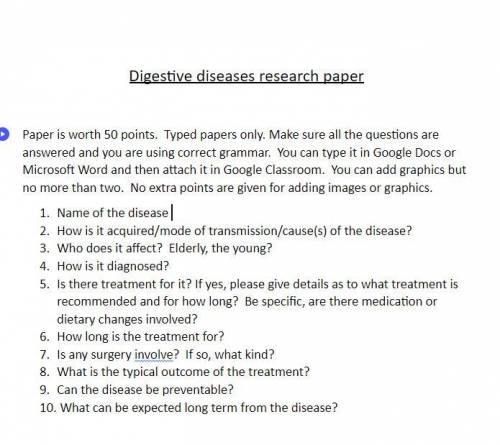Name of the disease
How is it acquired/mode of transmission/cause(s) of the disease?
Who does...

Biology, 05.02.2021 22:00 breemills9552
Name of the disease
How is it acquired/mode of transmission/cause(s) of the disease?
Who does it affect? Elderly, the young?
How is it diagnosed?
Is there treatment for it? If yes, please give details as to what treatment is recommended and for how long? Be specific, are there medication or dietary changes involved?
How long is the treatment for?
Is any surgery involve? If so, what kind?
What is the typical outcome of the treatment?
Can the disease be preventable?
What can be expected long term from the disease?
Help


Answers: 2


Other questions on the subject: Biology

Biology, 21.06.2019 20:30, Cocco
Dr. kaylan is an ecologist who studies bird behavior. she sets up an experiment to test which type of food crows are most likely to eat when given a choice between walnuts, corn, and sunflower seeds. to perform her experiment, dr. kaylan places three food bins in an area frequented by cows. each bin contains one of the three food types. then, she measures how much of each food type is eaten every day for a month and summarizes the results of her experiment in the pie chart below. based on her results, dr. kaylan concludes that crows choose to eat corn more frequently than other food sources because it has a higher nutritional value. what is a reasonable alternate conclusion that can be drawn from dr. kaylan's data
Answers: 2

Biology, 22.06.2019 00:10, haileysolis5
Which way do the nitrogenous bases in dna pair up? a. a and g; t and c b. a and c; t and g c. a and t; g and c d. a and a; t and t; g and g; c and c
Answers: 2

Biology, 22.06.2019 05:10, lilmsnyah
Hydrilla (hydrilla verticillata) is an invasive aquatic plant and one of the most serious aquatic pests in florida. hydrilla has already been introduced to hundreds of bodies of water throughout florida, hydrilla is difficult to control because it grows rapidly and survives in many different water depths and conditions. hydrilla • describe how hydrilla affects native plant and animal species. include both a biotic and an abiotic limiting factor. • suggest one biotic and one abiotic recommendation that could slow the spread of hydrilla
Answers: 3
You know the right answer?
Questions in other subjects:




Mathematics, 02.11.2020 19:00

Mathematics, 02.11.2020 19:00

History, 02.11.2020 19:00


Mathematics, 02.11.2020 19:00


Chemistry, 02.11.2020 19:00



